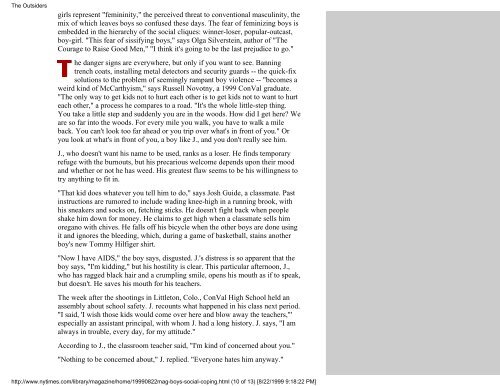The New York Times Magazine, Sunday, August 22 - Unauthorized ...
The New York Times Magazine, Sunday, August 22 - Unauthorized ...
The New York Times Magazine, Sunday, August 22 - Unauthorized ...
Create successful ePaper yourself
Turn your PDF publications into a flip-book with our unique Google optimized e-Paper software.
<strong>The</strong> Outsiders<br />
girls represent "femininity," the perceived threat to conventional masculinity, the<br />
mix of which leaves boys so confused these days. <strong>The</strong> fear of feminizing boys is<br />
embedded in the hierarchy of the social cliques: winner-loser, popular-outcast,<br />
boy-girl. "This fear of sissifying boys," says Olga Silverstein, author of "<strong>The</strong><br />
Courage to Raise Good Men," "I think it's going to be the last prejudice to go."<br />
he danger signs are everywhere, but only if you want to see. Banning<br />
trench coats, installing metal detectors and security guards -- the quick-fix<br />
solutions to the problem of seemingly rampant boy violence -- "becomes a<br />
weird kind of McCarthyism," says Russell Novotny, a 1999 ConVal graduate.<br />
"<strong>The</strong> only way to get kids not to hurt each other is to get kids not to want to hurt<br />
each other," a process he compares to a road. "It's the whole little-step thing.<br />
You take a little step and suddenly you are in the woods. How did I get here? We<br />
are so far into the woods. For every mile you walk, you have to walk a mile<br />
back. You can't look too far ahead or you trip over what's in front of you." Or<br />
you look at what's in front of you, a boy like J., and you don't really see him.<br />
J., who doesn't want his name to be used, ranks as a loser. He finds temporary<br />
refuge with the burnouts, but his precarious welcome depends upon their mood<br />
and whether or not he has weed. His greatest flaw seems to be his willingness to<br />
try anything to fit in.<br />
"That kid does whatever you tell him to do," says Josh Guide, a classmate. Past<br />
instructions are rumored to include wading knee-high in a running brook, with<br />
his sneakers and socks on, fetching sticks. He doesn't fight back when people<br />
shake him down for money. He claims to get high when a classmate sells him<br />
oregano with chives. He falls off his bicycle when the other boys are done using<br />
it and ignores the bleeding, which, during a game of basketball, stains another<br />
boy's new Tommy Hilfiger shirt.<br />
"Now I have AIDS," the boy says, disgusted. J.'s distress is so apparent that the<br />
boy says, "I'm kidding," but his hostility is clear. This particular afternoon, J.,<br />
who has ragged black hair and a crumpling smile, opens his mouth as if to speak,<br />
but doesn't. He saves his mouth for his teachers.<br />
<strong>The</strong> week after the shootings in Littleton, Colo., ConVal High School held an<br />
assembly about school safety. J. recounts what happened in his class next period.<br />
"I said, 'I wish those kids would come over here and blow away the teachers,"'<br />
especially an assistant principal, with whom J. had a long history. J. says, "I am<br />
always in trouble, every day, for my attitude."<br />
According to J., the classroom teacher said, "I'm kind of concerned about you."<br />
"Nothing to be concerned about," J. replied. "Everyone hates him anyway."<br />
http://www.nytimes.com/library/magazine/home/199908<strong>22</strong>mag-boys-social-coping.html (10 of 13) [8/<strong>22</strong>/1999 9:18:<strong>22</strong> PM]






